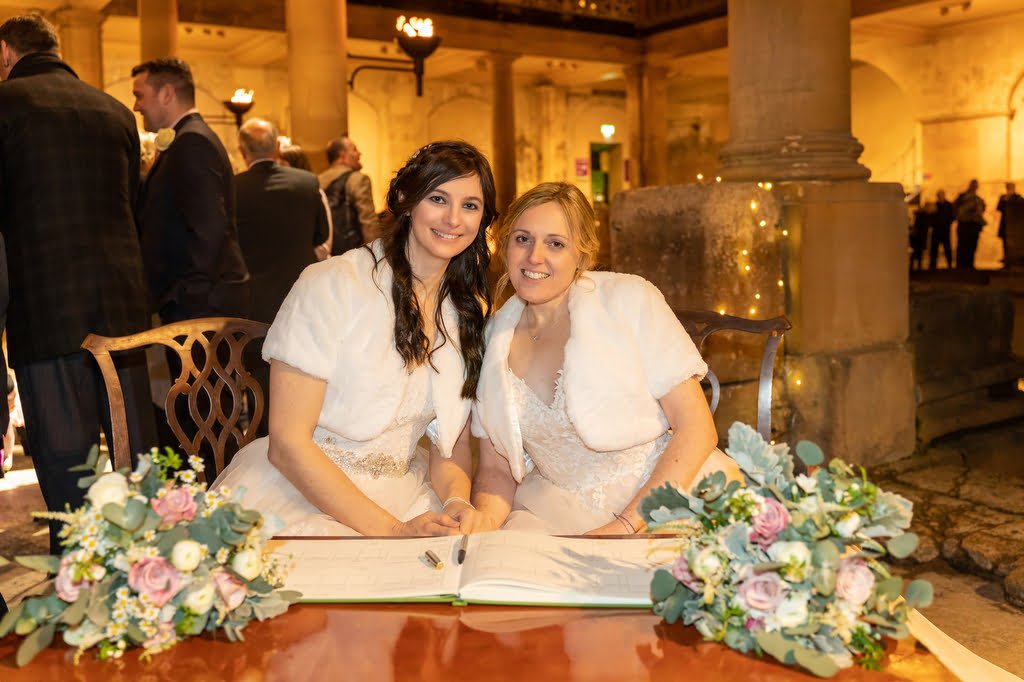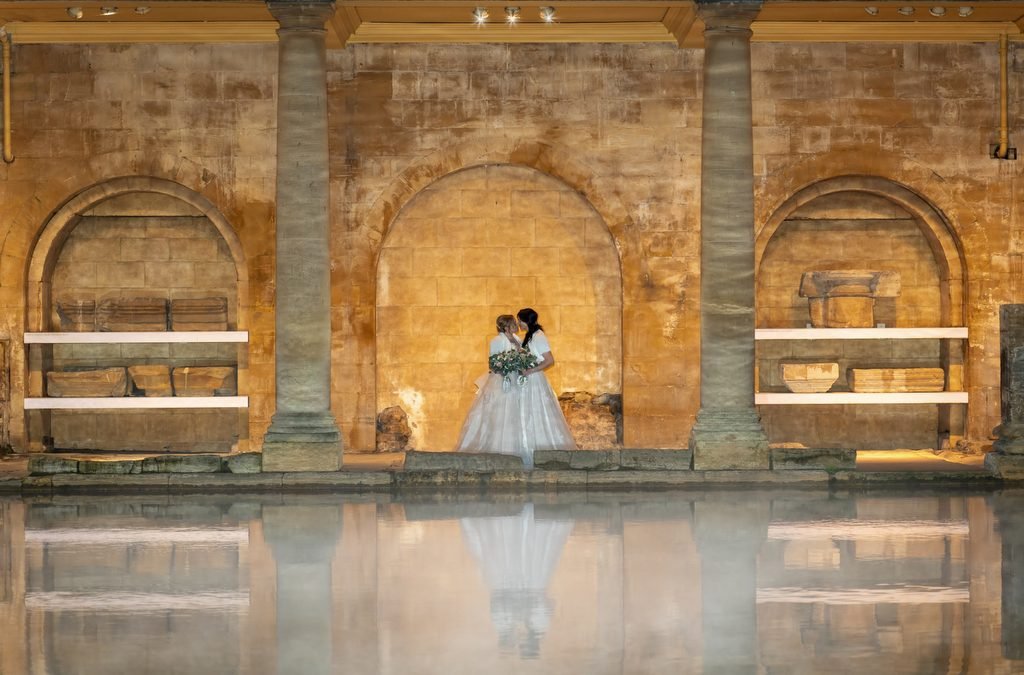The Roman Baths Weddings
Nestled in the heart of the charming city of Bath sits one of England’s most captivating historical sites: the remarkably well-preserved ancient Roman Baths. Dating back over 2,000 years to Roman times, this sprawling complex centered around a natural thermal spring provides a glimpse into the engineering marvels, architecture, culture, and customs of ancient Rome.
As you tour the grounds, the mystical green-hued waters of the Sacred Spring, soaring columns of the Circular Bath, and intricate mosaic tilework transport you back centuries to when this was the thriving epicenter of Roman Aquae Sulis. Each room imparts insights into various facets of Roman society and innovations that allowed an elaborate bathing complex and city to flourish.
The Mystifying Sacred Spring at the Heart of the Roman Baths
The Roman Baths’ mystique centers around its natural hot spring, which attracted settlers and pilgrims even before the Romans. With water temperatures steadily around 115°F, the thermal spring remains the only one of its kind in the entire United Kingdom – a true ancient wonder.
To Celtic and Roman cultures alike, these heated waters held sacred healing and religious powers, believed to be a gift from the gods reserved only for deities for much of history. As Bath grew into a bustling cosmopolitan city under Roman rule starting in 60 AD, public bathing became an integral part of both wellness and social culture.
The elaborate bathing complex, temples, steam rooms, treatment rooms, and expansive pools allowed public access to the revered waters for bathing, religious rituals, and relaxation. Today, the well-preserved remains invite visitors to walk in the footsteps of ancient Celts and Romans along the terraced pools and colonnaded baths.
The spring itself seems to defy science even today, with over one million liters of hot water flowing through the Baths each day at a rate of 300 liters per minute! The water maintains its mysterious heat and mineral composition as it bubbles up from the earth because it travels through several geothermal aquifers in the carboniferous limestone below.
This underground journey allows the waters to absorb an array of minerals including sulfate, chloride, calcium, sodium, and silica. Even the vivid green hue comes from algae that thrive in the warm environment. These compounds and properties contribute to the springs’ acclaimed healing, restorative, and therapeutic purposes. Visitors can sample the water for themselves at the Grand Pump Room.
Architectural and Engineering Marvels Creating Lavish Bathing Facilities
While the Sacred Spring itself captivates visitors, equally impressive feats of architecture and engineering surround it to create the magnificent bathing complex visitors see today. The ancient Romans were experts in bathhouse design and construction, creating over 800 bathhouses across their vast empire.
Bath provides uniquely well-preserved ruins that exemplify many key elements of Roman bathing culture and technology. The three main baths – the Sacred Spring Temple, the Circular Roman Temple, and the Great Bath – demonstrate distinct architectural designs tailored for group bathing.
The Sacred Spring Temple served religious purification rites with statues of the goddess Sulis Minerva, recognizing the spring’s Celtic spiritual roots. The Circular Roman Temple included smaller rounded bathing pools under an awe-inspiring domed ceiling with an oculus opening at the top. This design amplified the sacred ambiance.
The colossal Great Bath provided the most open bathing space for the general public, measuring an expansive 40 feet by 80 feet. Bathers could immerse themselves together in its waters, under the watch of statues honoring benefactors and deities positioned in ornate alcoves. Impressive columns with stepped seating line the Great Bath’s edges.
In addition to the baths themselves, the Romans also implemented cutting-edge systems to serve such a sizable complex. The ruins showcase intact examples of hypocaust heating – systems of raised floors and cavities within walls that circulated hot air from wood-fired boilers. This technology allowed bathwater and rooms to remain heated at comfortable temperatures.
Intricate drainage and supply systems with lead piping also moved water between pools and fountains. Though millennia old, these innovations demonstrate Roman engineers’ sophisticated grasp of hydraulics and heating principles.
The baths’ structures and surfaces feature exquisite details as well, from geometric mosaic floors crafted from millions of tiny square tiles to elegant friezes adorning walls. Archaeologists have uncovered over 500 elaborate stone carvings of lion heads, flowers, faces, and mythical creatures used as decor.
Skilled architects and artisans made every element complement others flawlessly to create both beautiful and fully functional bathing facilities. The Roman Baths stand as extraordinary examples of Roman bathhouses that have endured the ravages of time over centuries, still astonishing visitors today.
Sacred Offerings and Artifacts Providing a Window into Roman Aquae Sulis
In addition to the architectural sights, a visit to the Roman Baths provides an intimate glimpse into the everyday activities, religious practices, governance, and lives of Romans in Aquae Sulis (Bath). As you tour the grounds, you’ll find ancient shop fronts, temples, altars, and more that paint a fuller picture of Roman society.
For example, the elaborate pediment sculpture from the Temple of Sulis Minerva that once stood here exhibits intricate Celtic imagery and evidence of Roman gods absorbing earlier mythologies. Sacrificial treasures thrown into the sacred spring provide even more insights. Over 12,000 coins, curse tablets, jewelry, and other artifacts have been recovered from the muddy depths.
These votive offerings were pleas for good fortune, curses on enemies, or expressions of gratitude from bathers hoping to appease the gods and goddesses thought to rule the mystical waters. Visitors can glimpse many of these sacrificial artifacts up close in the on-site museum.
The museum also displays ancient stonework with inscriptions mentioning the names of Roman emperors, which provides evidence of historical dates when construction occurred. Local finds like coins and eating utensils reveal details of daily life. Together, these relics help paint a vivid picture of what the bustling sacred spring complex looked like at its peak when Romans gathered to bathe, pray, and socialize.
The resplendent 18th-century Grand Pump Room also demonstrates Bath’s enduring identity as a fashionable spa destination across eras. It’s soaring columns and crystal chandeliers set an elegant scene, allowing you to imagine well-dressed ladies and gentlemen socializing over the spring waters just as they did centuries ago. The Pump Room continues the time-honored tradition by serving glasses of natural spring water to visitors today.
The Rise, Abandonment, and Continued Preservation of the Roman Baths
While the baths thrived as part of grand Roman Aquae Sulis during the empire’s occupation of Britain, this part of Bath’s history nearly disappeared after the Romans withdrew around the year 410 AD. The bathing complex fell into disuse and disrepair, slowly buried under silt and debris for over 1,000 years.
It took rediscovery of the ruins and renewed interest in the mid-1700s to uncover the extent of the remains below Bath’s surface. As part of the Georgian reimagining of Bath into a fashionable spa town, the ancient baths were excavated and renovated. Though crumbling and worn, the foundations and hypocaust systems remarkably remained intact.
The connection of the ancient baths to the Pump Room helped launch Bath’s renaissance as a society destination. Archaeologists and architects also carried out additional excavations in the late 1800s, uncovering more original Roman structures including the Circular Temple and Temple Pediment. This allowed a fuller picture of the sprawling baths in their prime.
Ongoing restoration efforts, excavations, and studies in the 20th and 21st centuries have further contributed to understanding and maintaining the UNESCO World Heritage site. Visitors to the modern Roman Baths can download an app with interactive maps, historical images, and walkthroughs to visualize different eras.
The Roman Baths now rank as one of the most well-preserved ancient Roman spas in the world, astonishing visitors with this portal into 2,000-year-old engineering, culture, and rituals. From its geological mysteries to ornately carved figures presiding over sacred waters, a journey through this enduring complex is nothing short of time travel back to the ancient world.

The Roman Baths as an Elegant Wedding Venue in Modern Times
While the Roman Baths serve primarily as a museum and archaeological site showcasing Bath’s ancient history, couples today can also experience the magic of this location for their modern weddings. With special permissions and preparations, parts of the Roman Baths become an unforgettable backdrop for wedding ceremonies, photos, and more.
Exchanging Vows Surrounded by Myth and Grandeur
The open-air terrace overlooking the Great Bath provides a shining example of the baths’ potential for an awe-inspiring wedding venue. Here, couples exchange vows immersed in legend and antiquity, while guests gaze down at the steaming emerald waters that have mesmerized bathers for millennia.
Stone friezes depicting Roman deities like Minerva and Jupiter encircle you as if overseeing the vows. It conjures images of fantastical myths coming to life. The towering columns, vaulted ceiling, and intricately-patterned pavement underfoot add striking architectural details.
Couples can amplify the atmosphere further by arriving draped in Roman-inspired gowns and suits. This adds a theatrical element that transports guests back to the baths’ antiquity. From the bridal entrance to the ceremony itself, embracing the Roman setting creates an unforgettable affair.
Photography Capturing the Grandeur
The Roman Baths offer photographers an artistic treasure trove for wedding photos. Areas like the Grand Pump Room with its soaring pillars make a regal backdrop for portraits. The Bath House’s torches and colored light create moody, romantic images.
The interior walkway overlooking the Great Bath provides another vantage point for photos incorporating its grandeur from above. And the majestic Temple Pediment and Medieval statues throughout the grounds add visual interest.
Having access to photos in areas typically closed to standard visitors provides unique backdrops. The possibilities are endless for capturing the beauty juxtaposed with ancient relics when using the Roman Baths for wedding photography Bath.
Cocktail Hour and Reception in Atmospheric Spaces
In addition to the ceremony and photos, parts of the Roman Baths can transform for cocktail hour and wedding receptions. For example, the east baths near the museum provide a tucked-away terrace space for guests to sip cocktails amid the stone columns and projections.
The terrace overlooks steaming pools, creating a cozy, atmospheric setting. Temporary flooring and furniture dress the space for mingling. Nearby, the site’s historic dining room lined with Corinthian columns can host plated wedding meals under regal chandeliers.
The Bath’s unique enclosed areas lend themselves well to both intimate gatherings and larger receptions. Discerning couples can work with site planners to pick spaces that best suit their needs when using the Roman Baths as their wedding venue.
Coordination and Preparation Needed
As an active archaeological site and top tourist destination, sealing the Roman Baths for private nuptials requires significant coordination, preparation, and site fees. Strict guest limits, approved vendors, timed access, and more regulations are in place to protect the grounds’ integrity.
Couples also often hire Roman reenactment performers to boost ambiance. An extensive planning ensures the flow between the baths’ separated areas for ceremonies, cocktails, and receptions. But for those seeking an unparalleled romantic experience, the efforts pay dividends.
A Once in a Lifetime Celebration
Celebrating your nuptials at the Roman Baths offers a once-in-a-lifetime event that you and your guests will never forget. From the legends of ancient Aquae Sulis to the grandeur of the preserved ruins, it creates a breathtaking, magical day.
Starting your marriage surrounded by 2,000 years of history in one of England’s architectural treasures ensures a momentous, meaningful occasion. For couples wanting a truly remarkable wedding, the Roman Baths provide an awe-inspiring and fittingly romantic choice like no other.
So for those envisioning a ceremony as timeless as the elegant baths themselves, with photo backdrops evoking mythic eras, consider the Roman Baths for a wedding venue steeped in beauty, legacy, and wonder beyond compare.

